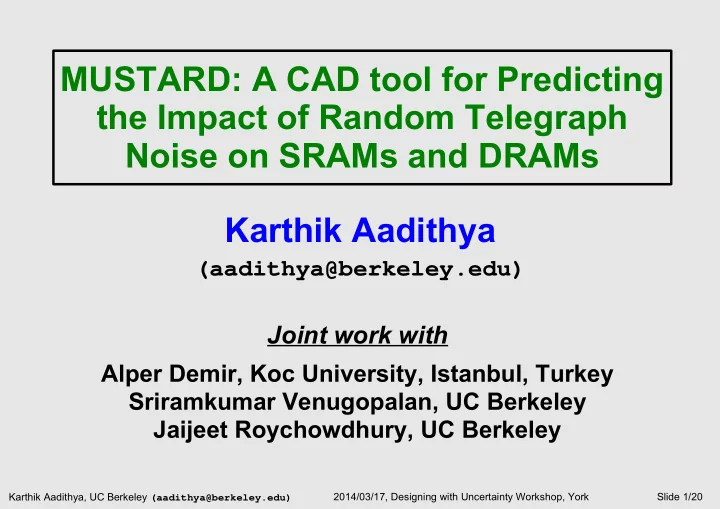

MUSTARD: A CAD tool for Predicting the Impact of Random Telegraph Noise on SRAMs and DRAMs Karthik Aadithya (aadithya@berkeley.edu) Joint work with Alper Demir, Koc University, Istanbul, Turkey Sriramkumar Venugopalan, UC Berkeley Jaijeet Roychowdhury, UC Berkeley Karthik Aadithya, UC Berkeley (aadithya@berkeley.edu) 2014/03/17, Designing with Uncertainty Workshop, York Slide 1/20
Overview of this talk • Why worry about RTN? (SRAMs, DRAMs) • RTN basics • Our contributions: RTN+circuit co-simulation • discrete Monte-Carlo ↔ nonlinear ckt. simulation Karthik Aadithya, UC Berkeley (aadithya@berkeley.edu) 2014/03/17, Designing with Uncertainty Workshop, York Slide 2/20
Importance of SRAMs and DRAMs Cache memory (L1, L2, L3, etc.) Core i7 die Millions of SRAM cells Laptop, desktop, tablet memories Billions of DRAM cells Karthik Aadithya, UC Berkeley (aadithya@berkeley.edu) 2014/03/17, Designing with Uncertainty Workshop, York Slide 3/20
6T SRAM cell: Write Operation ● Key idea: Back-to-back inverters ● Writing a 1 to the SRAM cell ● Switch BL to high, BL_bar to low ● Briefly enable WL ● By the end of the clock cycle ● Q should settle to 1 ● Q_bar should settle to 0 ● Cross-coupled inverter pair will maintain this (stable) state Karthik Aadithya, UC Berkeley (aadithya@berkeley.edu) 2014/03/17, Designing with Uncertainty Workshop, York Slide 4/20
How RTN can impact SRAM write RTN can induce dynamic SRAM write failure! (read failures also reported) Karthik Aadithya, UC Berkeley (aadithya@berkeley.edu) 2014/03/17, Designing with Uncertainty Workshop, York Slide 5/20
RTN in SRAMs: Experimental Evidence For each , record V dd Select V dd min, max fail bit count Write to SRAM Read from SRAM. Record errors. Fig. Credit: Seng O. Toh, PhD thesis, UCB Measured data ● Confirms temporal SRAM failures due to RTN ● Quantifies RTN in terms at circuit level V dd Karthik Aadithya, UC Berkeley (aadithya@berkeley.edu) 2014/03/17, Designing with Uncertainty Workshop, York Slide 6/20
Noise: An SRAM designer's viewpoint RTN impact is steadily increasing! At 22nm, RTN can drive design margins negative! Figure credits: Y. Tsukamoto, Renesas Electronics Corp . RTN-induced SRAM failures experimentally reported Seng et. al. (IEDM 2009), Yas et. al. (IRPS 2010) Karthik Aadithya, UC Berkeley (aadithya@berkeley.edu) 2014/03/17, Designing with Uncertainty Workshop, York Slide 7/20
What causes RTN? Release Capture Filled traps modify number, mobility of electrons in inversion layer Random Processes Change in drain current Measured as RTN Karthik Aadithya, UC Berkeley (aadithya@berkeley.edu) 2014/03/17, Designing with Uncertainty Workshop, York Slide 8/20
RTN is Non-Stationary Hz Release Capture V_gs Bias-dependence leads to non-stationary RTN Karthik Aadithya, UC Berkeley (aadithya@berkeley.edu) 2014/03/17, Designing with Uncertainty Workshop, York Slide 9/20
RTN: Bridging the Gap Device level Circuit level RTN ? MUSTARD RTN models measurements CAD tool incorporating device level RTN models for circuit level non-stationary RTN characterisation Karthik Aadithya, UC Berkeley (aadithya@berkeley.edu) 2014/03/17, Designing with Uncertainty Workshop, York Slide 10/20
MUSTARD's RTN Model Markov state affects Continuous DAE's q(.), f(.) Deterministic Differential Markov chain Coupled Algebraic Equations (RTN) (Rest of the circuit) Discrete Stochastic ongoing DAE solution affects Markov propensities Core idea: Simulate the bi-directionally coupled MC-DAE system using an intelligent Monte-Carlo scheme Karthik Aadithya, UC Berkeley (aadithya@berkeley.edu) 2014/03/17, Designing with Uncertainty Workshop, York Slide 11/20
MUSTARD: Non-stationary Trap Simulation with Bi-Directional Coupling Keep → update rate Discard → don't update rate Keep → update rate … and so on Karthik Aadithya, UC Berkeley (aadithya@berkeley.edu) 2014/03/17, Designing with Uncertainty Workshop, York Slide 12/20
MUSTARD: Simulation Methodology Start Generate candidate RTN event Simulate circuit until event Exact, non-stationary Discard statistics preserved! Probabilistically decide: keep (or) Discard discard event? Keep Keep! Update circuit equations Karthik Aadithya, UC Berkeley (aadithya@berkeley.edu) 2014/03/17, Designing with Uncertainty Workshop, York Slide 13/20
MUSTARD: Individual SRAM cell No RTN No V_th variability No RTN Yes V_th variability Yes RTN Yes V_th variability Karthik Aadithya, UC Berkeley (aadithya@berkeley.edu) 2014/03/17, Designing with Uncertainty Workshop, York Slide 14/20
RTN+Variability: MUSTARD on 6T SRAM across (V DD ,V th ) landscape Without RTN With RTN Karthik Aadithya, UC Berkeley (aadithya@berkeley.edu) 2014/03/17, Designing with Uncertainty Workshop, York Slide 15/20
MUSTARD-generated BER vs VDD plots ● asdf Karthik Aadithya, UC Berkeley (aadithya@berkeley.edu) 2014/03/17, Designing with Uncertainty Workshop, York Slide 16/20
MUSTARD: RTN Effects on DRAMs ● asdf Karthik Aadithya, UC Berkeley (aadithya@berkeley.edu) 2014/03/17, Designing with Uncertainty Workshop, York Slide 17/20
Summary and Conclusions ● RTN is a concern for SRAM scaling ● Bottom-up prediction of bit errors challenging ● discrete random events + non-stationarity + “feedback” ● MUSTARD offers a simulation-based solution ● strong mathematical guarantee on accuracy: applies to • any trap configuration • any circuit (SRAM, DRAM, etc.) • any device model, any model for RTN, etc. Karthik Aadithya, UC Berkeley (aadithya@berkeley.edu) 2014/03/17, Designing with Uncertainty Workshop, York Slide 18/20
Publications (1) Aadithya V Karthik, Alper Demir, Sriramkumar Venugopalan and Jaijeet Roychowdhury. SAMURAI: An accurate method for modelling and simulating non-stationary Random Telegraph Noise in SRAMs. In Proceedings of the Design, Automation and Test Conference in Europe, 2011. (2) Aadithya V Karthik, Sriramkumar Venugopalan, Alper Demir and Jaijeet Roychowdhury. MUSTARD: A coupled, stochastic-deterministic, discrete-continuous technique for predicting the impact of Random Telegraph Noise on SRAMs and DRAMs. In Proceedings of the Design Automation Conference 2011. (3) Aadithya V Karthik, Alper Demir, Sriramkumar Venugopalan, and Jaijeet Roychowdhury. Accurate Prediction of Random Telegraph Noise Effects in SRAMs and DRAMs. In the 2013 IEEE Transactions on Computer-Aided Design of Integrated Circuits and Systems, Volume 32, Issue 1. Karthik Aadithya, UC Berkeley (aadithya@berkeley.edu) 2014/03/17, Designing with Uncertainty Workshop, York Slide 19/20
Recommend
More recommend